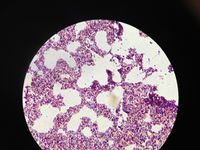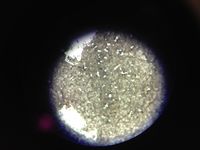Template talk:Genus hollingsworth
Classification
Domain: Bacteria, Phylum: Firmicutes, Class: Bacilli, Order: Bacillales, Family: Bacillales Family XII. Incertae Sedis, Genus: Exiguobacterium, Species: Unknown
Habitat Information
This soil organism was collected in the Hill Country of Fredericksburg, Texas. The soil was very soft and moist, about 5-6" in depth.
There are at least 13 different strains of exoquibacterium, the first being discovered in a potato plant by Collins et al. in 1983. Since that time, others have been found in the Siberian frost, glaciers in Greenland, Yellowstone National Park hot springs and various other locations of extreme temperatures.
Description and Significance
Exiguobacterium are small, irregular rod shaped bacteria, or coccobacilli. Stains performed on our organism revealed a positive gram stain and small capsules. This organism was negative for endospores. The ability of exiguobacterium to survive in extreme temperatures (-12C - 55C) and grow within a large range of pH (5-11) make this bacteria an important area of study. It has also shown to be tolerant of UV radiation and heavy metal stress.
Genome Structure
Describe the size and content of the genome. How many chromosomes? Circular or linear? Other interesting features? What is known about its sequence? Include S Ribosomal sequence that you obtained from PCR and sequencing here.
16S rRNA genome
GCACGCCGCGTGAGTGATGAAGGTTTTCNGANNGTAAAACTCTGTTGTAAGGGAAGAACACGTACGAGAGGAAATGCTCGTACCTTGACGGTACCTTACGAGAAAGCCACGGCTAACTACGTGCCAGCAGCCGCGGTAATACGTAGGTGGCAAGCGTTGTCCGGAATTATTGGGCGTAAAGCGCGCGCAGGCGGCCTTTTAAGTCTGATGTGAAAGCCCCCGGCTCAACCGGGGAGGGCCATTGGAAACTGGAAGGCTTGAGTACAGAAGAGAAGAGTGGAATTCCACGTGTAGCGGTGAAATGCGTAGAGATGTGGAGGAACACCAGTGGCGAAGGCGACTCTTTGGTCTGTAACTGACGCTGAGGCGCGAAAGCGTGGGGAGCAAACAGGATTANATACCCTGGTAGTCCACGCCGTAAACGATGAGTGCTAGGTGTTGGGGGGTTTCCGCCCCTCAGTGCTGAAGCTAACGCATNTANGCACTCCGCCTGGNGAGTACGGCCGCAAGGCTNAAACTCNAAGGANTTGACGGGGACCCGCACAATCGGGGGCACGCCGCGTGAGTGATGAAGGTTTTCNGANNGTAAAACTCTGTTGTAAGGGAAGAACACGTACGAGAGGAAATGCTCGTACCTTGACGGTACCTTACGAGAAAGCCACGGCTAACTACGTGCCAGCAGCCGCGGTAATACGTAGGTGGCAAGCGTTGTCCGGAATTATTGGGCGTAAAGCGCGCGCAGGCGGCCTTTTAAGTCTGATGTGAAAGCCCCCGGCTCAACCGGGGAGGGCCATTGGAAACTGGAAGGCTTGAGTACAGAAGAGAAGAGTGGAATTCCACGTGTAGCGGTGAAATGCGTAGAGATGTGGAGGAACACCAGTGGCGAAGGCGACTCTTTGGTCTGTAACTGACGCTGAGGCGCGAAAGCGTGGGGAGCAAACAGGATTANATACCCTGGTAGTCCACGCCGTAAACGATGAGTGCTAGGTGTTGGGGGGTTTCCGCCCCTCAGTGCTGAAGCTAACGCATNTANGCACTCCGCCTGGNGAGTACGGCCGCAAGGCTNAAACTCNAAGGANTTGACGGGGACCCGCACAATCGGGG
Cell Structure, Metabolism and Life Cycle
Interesting features of cell structure; how it gains energy; what important molecules it produces.
Exiguobacterium are facultative and fermentative in their metabolism. This is a catalase positive organism that produces acid from glucose, sucrose, maltose and mannitol. Cell structure composed of Peptidoglycan de-amino acid, L-Lysine. This organism is positive for menaquinone MK-7, a form of Vitamin K produced by bacteria in the intestine that is important for blood clotting. Cellular fatty acids include C17;Oi, C15;Oi, C16O.
Physiology and Pathogenesis
Biochemical characteristics, enzymes made, other characteristics that may be used to identify the organism; contributions to environment (if any).
If relevant, how does this organism cause disease? Human, animal, plant hosts? Virulence factors, as well as patient symptoms.
Gelatin Hydrolysis: gelatinase negative
DNA Hydrolysis: DNase positive
Lipid Hydrolysis: lipase negative
Phenol Red Broth:
Starch Hydrolysis: alpha-amylase positive
Casein Hydrolysis: casease positive
Methyl Red: positive for mixed acids
Voges-Proskauer: negative
Citrate: negative
SIM: sulfur reduction - negative, indole reaction - negative, motility - light, feathery growth which indicates a weak positive
Nitrate Reduction: does not reduce nitrate
Urea Hydrolysis: negative
Triple Iron Sugar: positive glucose and lactose fermentation, does not reduce sulfur
Decarboxylation: does not produce decarboxylase
Phenylalanine Deaminase: negative
Oxidase: negative
Eosin Methylene Blue Agar: negative
Hektoen Enteric Agar: negative
MacConkey Agar: negative
Catalase: positive
Blood Agar: gamma hemolysis
Mannitol Salts Agar: growth, weak positive for mannitol fermentation
Phenylethyl Alcohol Agar: growth, confirms that organism is Gram positive
Bacitracin/Optochin Susceptibility: not susceptible to bacitracin or optochin
Bile Esculin: hydrolyzes esculin
6.5% Salt Tolerance: negative
Kirby-Bauer Antimicrobial Susceptibility Tests for disinfectants: strongly susceptible to bleach, lysol, and lavender but only weakly susceptible to tea tree oil
Kirby-Bauer Antimicrobial Susceptibility Tests for antibiotics: strongly susceptible to ampicillin, linezolid, ticarcillin/clavulanic acid, and ceftazidime
Enzymes cleansed from exiguobacterium samples are alkaline protease, EKTA catalase, guanosine kinase, ATPases, dehydrogenase, and esterase. http://www.vp-scientific.com/reference-pdf/Extremophiles-2009-Vishnivetskaya.pdf
This bacteria has possible antimicrobial activity in that at least one of the species may aid in the digestion of plastics by mealworms. http://www.ncbi.nlm.nih.gov/pubmed/26390390
One species (Exiguobacterium sibiricum) may cause human skin infection. http://www.ncbi.nlm.nih.gov/pmc/articles/PMC4257833/
Other strains of exiguobacterium are known to promote growth in plants. http://www.ncbi.nlm.nih.gov/pmc/articles/PMC3299478/
In 2005, a documented case of an elderly woman with a hospital-acquired (acetylicum) exiguobacterium infection following a long hospital stay and need for catheter care while inpatient. Her symptoms included urinary retention, fever, tachycardia and leukocyturia. She was treated with cefuroxime. http://jmm.microbiologyresearch.org/content/journal/jmm/10.1099
References
http://www.bacterio.net/exiguobacterium.html
Koneman's Color Atlas and Textbook of Diagnostic Microbiology, edited by Elmer W. Koneman, Google Books
Author
Page authored by Danielle St.Romain and Heather McMillion, students of Prof. Kristine Hollingsworth at Austin Community College.


